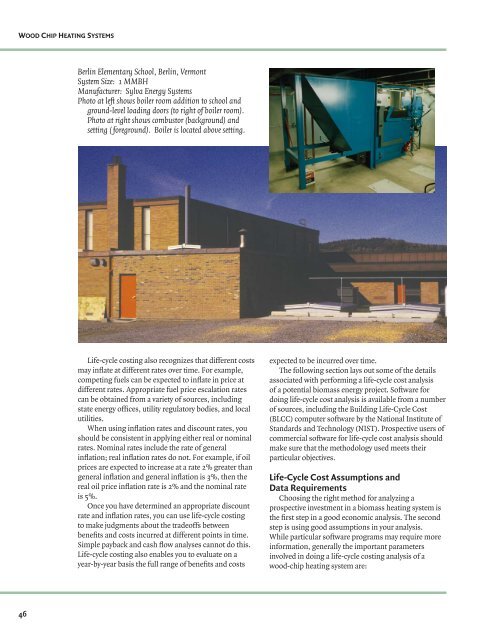Wood-Chip Heating Systems - Biomass Energy Resource Center
Wood-Chip Heating Systems - Biomass Energy Resource Center
Wood-Chip Heating Systems - Biomass Energy Resource Center
Create successful ePaper yourself
Turn your PDF publications into a flip-book with our unique Google optimized e-Paper software.
WOOD CHIP HEATING SYSTEMS<br />
46<br />
Berlin Elementary School, Berlin, Vermont<br />
System Size: 1 MMBH<br />
Manufacturer: Sylva <strong>Energy</strong> <strong>Systems</strong><br />
Photo at left shows boiler room addition to school and<br />
ground-level loading doors (to right of boiler room).<br />
Photo at right shows combustor (background) and<br />
setting ( foreground). Boiler is located above setting.<br />
Life-cycle costing also recognizes that different costs<br />
may infl ate at different rates over time. For example,<br />
competing fuels can be expected to infl ate in price at<br />
different rates. Appropriate fuel price escalation rates<br />
can be obtained from a variety of sources, including<br />
state energy offi ces, utility regulatory bodies, and local<br />
utilities.<br />
When using infl ation rates and discount rates, you<br />
should be consistent in applying either real or nominal<br />
rates. Nominal rates include the rate of general<br />
infl ation; real infl ation rates do not. For example, if oil<br />
prices are expected to increase at a rate 2% greater than<br />
general infl ation and general infl ation is 3%, then the<br />
real oil price infl ation rate is 2% and the nominal rate<br />
is 5%.<br />
Once you have determined an appropriate discount<br />
rate and infl ation rates, you can use life-cycle costing<br />
to make judgments about the tradeoffs between<br />
benefi ts and costs incurred at different points in time.<br />
Simple payback and cash fl ow analyses cannot do this.<br />
Life-cycle costing also enables you to evaluate on a<br />
year-by-year basis the full range of benefi ts and costs<br />
expected to be incurred over time.<br />
The following section lays out some of the details<br />
associated with performing a life-cycle cost analysis<br />
of a potential biomass energy project. Software for<br />
doing life-cycle cost analysis is available from a number<br />
of sources, including the Building Life-Cycle Cost<br />
(BLCC) computer software by the National Institute of<br />
Standards and Technology (NIST). Prospective users of<br />
commercial software for life-cycle cost analysis should<br />
make sure that the methodology used meets their<br />
particular objectives.<br />
Life-Cycle Cost Assumptions and<br />
Data Requirements<br />
Choosing the right method for analyzing a<br />
prospective investment in a biomass heating system is<br />
the fi rst step in a good economic analysis. The second<br />
step is using good assumptions in your analysis.<br />
While particular software programs may require more<br />
information, generally the important parameters<br />
involved in doing a life-cycle costing analysis of a<br />
wood-chip heating system are:





